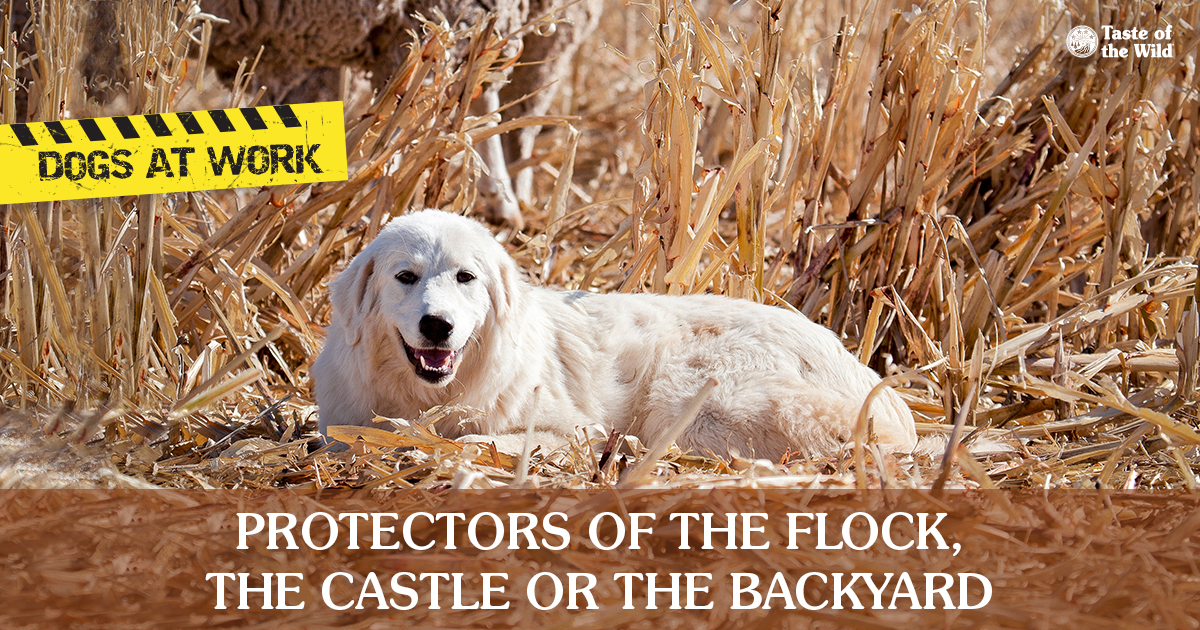
Named for the mountains that form the border between France and Spain, Great Pyrenees were bred to work beside shepherds and their flocks. They didn’t actually drive the sheep (other herding dogs were responsible for that); instead, they served as guard dogs, protecting the flock from wolves, bears and sheep rustlers.
The massive white dogs typically strode ahead of the flock to inspect the area for predators, then created a safe perimeter around the flock. Given that these dogs can reach 100 pounds or more and 32 inches in height, they created an intimidating presence — unless, of course, their thick, white coats blended with the flock or the snowy surroundings, enabling them to take intruders by surprise.
Guardians of the flock eventually became protectors of castles, with Great Pyrenees serving as guard dogs at the Chateau of Lourdes during the 15th century. Once they were named the Royal Dog of France in the court of King Louis XIV, every noble family wanted one.
Although the first pair of Great Pyrenees was brought to America in 1824 by General Marquis de Lafayette, as a gift to his friend, J.S. Skinner, author of “The Dog and the Sportsman,” the breed wasn’t recognized by the American Kennel Club until 1933.
Today, Great Pyrenees still guard livestock, but many are family companions. Given their background, they can be good rescue dogs in mountainous terrain, but they can also serve as gentle therapy dogs. They’re excellent guard dogs, even if they live in the suburbs.
Fun facts about Great Pyrenees
- During World War II, Great Pyrenees carried artillery over the mountains between France and Spain.
- Barry Gibb of Bee Gees fame is said to have owned a Great Pyrenees named Barnaby.
- In the United Kingdom and most of Europe, they’re known as the Pyrenean mountain dog. In France, they’re called le chien de montagne des Pyrénées, le chien des Pyrénées or simply “patou” which comes from the word “pastre,” meaning shepherd or shepherd’s dog.
- While many mountain herding dogs are considered molossoid, meaning they retain the heavier bone structure and short muzzles of mastiffs, Great Pyrenees are lupomolossoid, meaning that they tend to have longer muzzles and thinner bodies, more like European grey wolves.
- Fossils of Great Pyrenees dating from the Bronze Age (1800 to 1000 B.C.) have been unearthed in the area, but they are thought to have originated in Asia Minor some 11,000 years ago.
- In 1662, Basque fishermen brought Great Pyrenees to Newfoundland, where the dogs were crossed with the black curly coated retriever, creating the black and white Landseer Newfoundland.
- After centuries of guarding sheep well into the night, Great Pyrenees today can be somewhat nocturnal, barking to alert owners if a creature stirs in the wee hours of the morning.
The information in this blog has been developed with our veterinarian and is designed to help educate pet parents. If you have questions or concerns about your pet's health or nutrition, please talk with your veterinarian.
